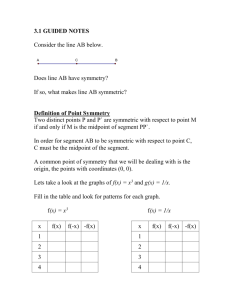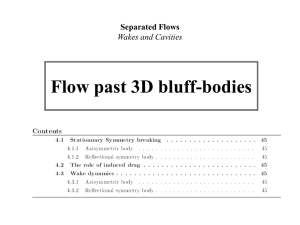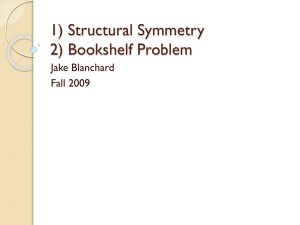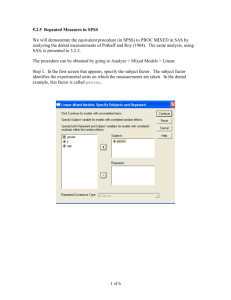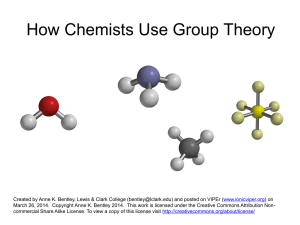Symmetry-based Test Hypothesis`s
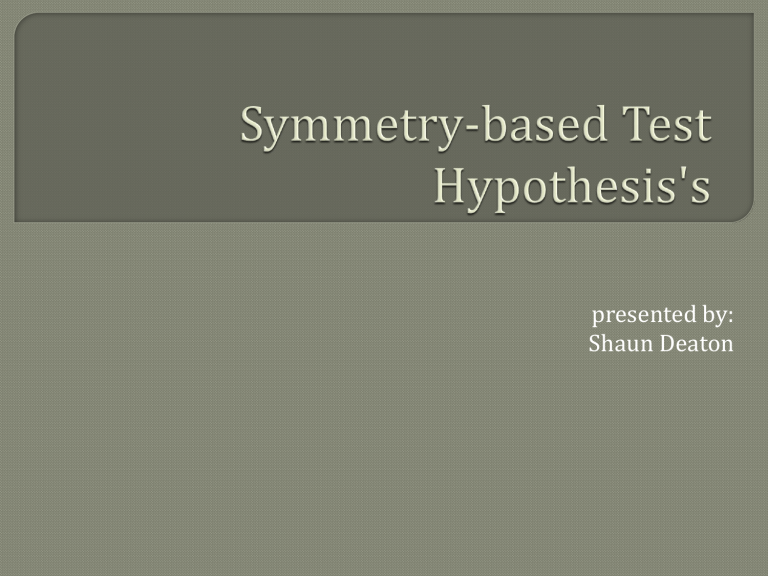
presented by:
Shaun Deaton
The idea is to hypothesize constraints on the interchangeability of N normally distributed random variables. Then test the hypothesis by using the likelihood ratio of the determinants of the covariance matrices. The symmetry constraints impose structure upon the vector of means and the covariance matrix.
Depending on the experimental setup, the measurement variables can be grouped together in various ways; forming many different possible partitions into non-overlapping subsets.
In this construction there are two main types of interchanging that can happen:
• Permuting variables in the same subgroup.
• Permuting variables between distinct subgroups.
E.g. Let there be three tests given to measure a subject’s knowledge or skills; assume these are all normally distributed when taken over a large sample of subjects. Under one possible interchangeability hypothesis, it is assumed that the means are the same, variances are same, and co-variances are all the same.
X X X X vector & covariance matrix have the following form:
)
mv
A B B
B A B
B B A
Here the ‘mv’ notation is means, variances, & co-variances are all respectively equal as assumed above.
For the experimental situations considered in the references (1), there is usually an “outside criterion measure”, which could be a specialized reference measurement. This new random variable, the fourth in this example, is assumed to also be normal and have the following form for the mean vector and covariance matrix:
X X X X X with standard matrix pattern.
4 1 1 1
)
mvc
D C C C
C A B B
C B A B
C B B A
Whenever a model has this structure it is said to have
Compound Symmetry of Type 1.
Now the ‘c’ in ‘mvc’ says that all co-variances between subsets are equal.
Concrete Example from reference (2): The sample vectors in this case
X
( v q m s ss m s ss
2
)
( x x x
3
)
, where v=verbal, q=quantitative, m=math, s=science, & ss=social studies.
This case considers only two successive measurements on m, s, & ss, generally may have several measurements.
1 2 2
)
mvc
D C C
C A B
C B A
Here the elements are matrices: D is 2x2 symmetric, C is 2x3, A is 3x3 symmetric, & B is 3x3 symmetric.
This is known as Block Compound Symmetry of Type 1 (BCS-1).
Concrete Example from reference (1): Consider a collection of animals from which the %CO
2 and %O
2 in their blood will be measured twice each day of the experiment. Assuming these four variables are normally distributed the symmetry model of the preceding example takes the following form:
X
( UT UT WT WT
2
)
Where UT
1
WT
1 and animal.
and
WT
2
UT
2 are the first & second are the first & second %O
2
%CO
2 measurements, while measurements on the same
Now, the hypothesis to be tested is given by:
1 1 2 2
)
mvc
E
F
K L G J
L
F
E
K
K
L
J
L
K
G
Whenever the means, variances, and co-variances, both between and
Among the subsets of partitioned variables have a structure like that in the last example, the model is said to have Compound Symmetry of
Type 2. Just as for the Type 1 case, it can be extended to the Block
Compound Symmetry of Type 2 (BCS-2) by considering partitions of vectors into subsets of equal size.
t
y
(
x x x x x x x x
3
)
under the Block Compound Symmetry of type 2 condition, the new vector
As a further example, and note of caution, consider four r-D normally
(
, |
1 3
4
) x
, obtained by permutation, has the same
s
(
x x x x
(
4
, x
| ,
)
)
Votaw considers a further restriction on the covariance matrix, by assuming that the off-diagonal co-variances where equal, as well as the on-diagonal entries as before. Obtaining twice the number of hypotheses to test. Have general form of these matrices in reference (1).
The distribution is said to have Complete Symmetry, if whenever some partition of the variates satisfies H
1
(***) it satisfies H
1
(***) , and vice-a-versa; the ‘*’ are wildcards. When just one of these hypotheses is satisfied the distribution is called Compound Symmetric. The bar notation is taken in the sense of Votaw, denoting the off-diagonal covariance condition.
Another Example:
In reference (3), there is a example where some number k, of seismographs, are placed symmetrically around a mountain (or volcano).
Then it would be possible to test for circular symmetry in the combined data from all k instruments. …
References:
1 Testing Compound Symmetry in a Normal Multivariate Distribution; by David F. Votaw jr.
2 Testing and Estimation in the Block Compound Symmetry Problem; by Ted H. Szatrowski.
3 Comment: Group Symmetry Covariance Models; by Michael D. Perlman.

